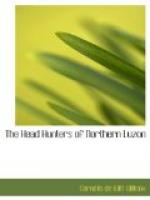But this is not all. The Filipino peoples are divided into two great classes, the Christian and the non-Christian. Now, these non-Christians number over a million, and are themselves broken up into many subdivisions, not only differing in language, customs, habits and traditions, but until very recently bitterly hostile to one another, and so low in the scale of political development that, unlike our own Indians, they have never risen to any conception of even tribal government or organization. Moreover, in Moroland, in the great island of Mindanao with its neighbors, the situation is further complicated by the fact that the dominant elements are Mohammedan. Over most of these non-Christians the Spaniards had not even the shadow of control. The appellation “Filipino people” is therefore wholly erroneous; more than that, it is even dangerously fallacious, in that its use blinds or tends to blind our own people to the real conditions existing in the Archipelago. It is correct to speak of the Filipino peoples, because this expression is, geographically, accurately descriptive; but it is absolutely misleading to speak of the Filipino people, because of the false political idea involved and conveyed by the use of the singular number. Similarly, there is no objection to the term “Filipino” or “Filipinos,” so long as we understand it to mean merely an inhabitant or the inhabitants of the Philippine Archipelago, more narrowly the Christianized inhabitant or inhabitants; but it is distinctly wrong to give to the term a political or national color. It may be remarked now that the divisions, both Christian and non-Christian, of which we have been speaking, determined as they are




